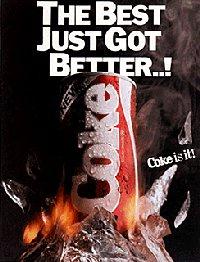New Coke
|
|

CokeII.jpg
- For the main article on the company, see The Coca-Cola Company. For the main article on the beverage, see Coca-Cola.
New Coke, renamed Coke II in 1990, was the sweeter drink introduced in 1985 by The Coca-Cola Company to replace its flagship soda, Coca-Cola. Public reaction was devastating, and the new cola quickly entered the pantheon of major marketing flops. However, the subsequent reintroduction of Coke's original formula led to a significant gain in sales, which some theorize was the original purpose all along.
The original drink's market share had been shrinking for decades, from 60 percent just after World War II to under 24 percent in 1983. In the company's search for a remedy, their product testers determined that many people preferred the sweeter taste of Pepsi. Executives decided to introduce a new version, featuring the formula of Diet Coke sweetened with high fructose corn syrup instead of aspartame. To preserve secrecy during pre-marketing taste tests, Coca-Cola marketers never asked the focus groups, "How about if this product replaced Coke?" New Coke was introduced on April 23, 1985, with the slogan "The Best Just Got Better." Production of the original formulation ended that same week.
It was a marketing and public relations debacle. The public was unhappy with the new taste, and even more unhappy that they were no longer able to obtain the original product. Humbled, Coca-Cola executives announced the return of the classic cola on July 10, less than three months after New Coke's introduction. Many who tasted the hastily reintroduced classic formula were not convinced that the first batches really were old Coke.
"There is a twist to this story which will please every humanist and will probably keep Harvard professors puzzled for years," said Donald Keough, president and chief operating officer, at a press conference. "The simple fact is that all the time and money and skill poured into consumer research on the new Coca-Cola could not measure or reveal the deep and abiding emotional attachment to original Coca-Cola felt by so many people."
The reintroduction of the original formula, now renamed Coke Classic or Coca Cola Classic, propelled demand, helping to save Coca-Cola's market lead over Pepsi. Some believe this was the deliberate purpose of introducing New Coke. Others believe New Coke was intended to distract consumers from the switch from cane sugar to corn syrup—even though Coca-Cola in the U.S. contained corn syrup since 1980, before New Coke was introduced, which had already been criticized by Coke purists.
Still others contend that the beverage's natural flavorings include coca plant extracts similar to cocaine, and that the reformulation removed these to placate the Drug Enforcement Administration, which was trying to eradicate the coca plant worldwide.
In 1985, New Coke was sold only in North America, while the original formula continued to be sold in the rest of the world (although had the new version been a success it would presumably have been introduced worldwide). But New Coke was eventually returned to the company's product portfolio; it was test-marketed under the name Coke II in 1990 and officially renamed Coke II in 1992.
The New Coke fiasco led Bill Cosby to end his advertising for Coke. He said his commercials that praised the superiority of the new formula had hurt his credibility.
Before New Coke's introduction in 1985, Coca-Cola had been losing market share primarily to Pepsi. Although the reason was originally thought to be Pepsi's sweeter taste, a major force in the shift of market share was due to the merger between PepsiCo and Frito-Lay. PepsiCo was able to take advantage of Frito-Lay's highly developed retail distribution system to leverage more shelf space at supermarkets and other food retailers. With more shelf space available, sale specials were common for Pepsi products. Price, not loyalty, was the motivating factor for most retail consumers, and Pepsi gained substantial market share as a result.
See also
External links
- Barbara Mikkelson's brief guide to the lucky fiasco (http://www.snopes.com/cokelore/newcoke.asp)
- Coca-Cola history on New Coke (http://www2.coca-cola.com/heritage/cokelore_newcoke.html)
- God, What a Blunder: The New Coke Story By Michael Bastedo Angela Davis (http://members.lycos.co.uk/thomassheils/newcoke.htm) With a good talk on the problems of their research methodologies (focus groups v. surveys).
- QuickTime news clip on New Coke introduction (http://edition.cnn.com/resources/video.almanac/1985/coke/new.coke.50sec.lg.mov) from KTLA news in Los Angeles, courtesy of CNN.com
Categories: Coca-Cola | Coca-Cola brands | Flops | Cola
